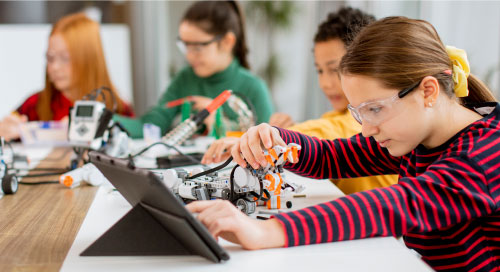Fill form to unlock content
Error - something went wrong!
Your content is just a step away. Please submit below.
Thank you!
Level Up Learning with Gamified AI in the Classroom

With AI’s rapid evolution, we’re witnessing a monumental societal shift as it influences our day-to-day lives. In many ways, school-age children experience this the most. So, how can we nurture innovation in the classroom and teach them new skills? How can we equip them with an essential foundation for responsible AI use and provide them with ethical guidelines for developing AI that benefits society?
meldCX, a provider of AI and edge computing solutions, tackles these challenges. “When AI is used appropriately and with the correct strategy, it augments existing resources to assist students in a one-to-one fashion and tailored to individual needs,” says Stephen Borg, Group Chief Executive Officer of meldCX.
But there are barriers in adopting AI, such as concerns for student privacy, limited budgets, and lack of skills needed to integrate AI in the classroom. That’s why Borg and his team developed the AI Playground, a cost-effective and safe environment for students to experience and explore AI.
Building AI-Based Solutions in the Classroom
The AI environment is presented to students as a Lego-based competitive game. For instance, students work with brick kits that come in a range of levels—from a beginner pack of six to an advanced 100-piece unit—to create an AI model. A camera is used to help guide students about where to place the parts. And to protect their privacy, and to model ethical use of AI, the camera is situated to focus only on the students’ hands.
In one example, students created a Mars Rover model. Once it was complete, they could use the playground’s software to “launch” it into space, land it on Mars, and explore surrounding areas (Video 1).
The AI software can stream educational information about the Red Planet, subtly making it a science-based learning lesson. Students can also compete against one another in timed events to see who can launch their Rover in the shortest amount of time.
AI Playground was built in collaboration with Intel and the University of South Australia, and leverages meldCX’s vision analytics platform Viana to provide insights into the lesson. In the Mars Rover example, the game uses AI-based object detection programs to recognize the Lego bricks and various stages of the Rover creation process.
Schools can get started with a basic web camera, a display screen, an Xbox controller, Lego bricks, and Intel® Core™ Processors.
“When #AI is used appropriately and with the correct strategy, it amplifies existing resources to be able to assist students in a one-to-one fashion, where the pace is tailored to individual needs” – Stephen Borg, meldCX via @insightdottech
Intel® OpenVINO™ Optimizes AI Development
The team at meldCX overcame several challenges to design the AI Playground. “The playground needed to detect similar objects of varying size, so we had to create and train models for each individual part,” says Borg. “And our partnership with Intel was pivotal to navigating the development process.”
The Intel ® OpenVINO™ toolkit plays a significant role in developing innovative object detection and vision solutions in several ways:
- Hardware-agnostic design enables developers to choose what best suits their specific application by supporting a wide range of accelerators, including CPUs and GPUs.
- Optimization tools help developers reduce model size and memory footprint, accelerating inference for deep learning models in object detection and vision solutions.
- Inference at the edge brings more object detection and vision solution deployment flexibility at the edge, where latency and bandwidth constraints often demand local processing.
- Different front-ends provide for integration with popular deep-learning frameworks like TensorFlow and PyTorch. Models trained with these frameworks can take advantage of OpenVINO optimization and deployment capabilities.
“OpenVINO allows us to deploy multiple concurrent models on a single edge device, optimize those models without compromising performance, and produce smooth, real-time previews of the detections,” says Borg. Its optimization and accelerated inference programs also allow solutions like meldCX to support expensive GPUs to run models on CPUs, allowing for school programs with a limited budget to be able to afford quality AI education solutions.
The Future of AI in the Classroom
“Our mission is to participate in the ethical practice of AI and bring it to life. We are committed to use AI as a tool to augment human capabilities,” says Joy Chua, Executive Vice President of Strategy and Development at meldCX. “As we’re moving toward a more digital future, it is important for us to empower our students to be first-class innovators, supported by first-class AI.”
AI Playground has the potential to shape the future of education and build foundational knowledge early on for the next generation of developers. For instance, AI Playground gives students a peek into how AI works while also learning the subject of the game. “It’s important to expose students to AI and inspire them to see possibilities,” says Raymond Lo, AI Software Evangelist at Intel. “Computer vision is especially exciting because it helps kids make sense of a scene and then detect and extract information.”
And that’s a lesson educators take to heart.
This article was originally published April 20, 2023.
This article was edited by Leila Escandar, Editorial Strategist for insight.tech.